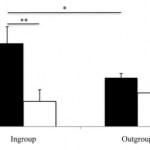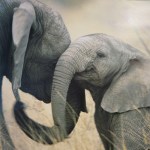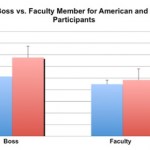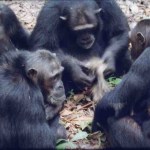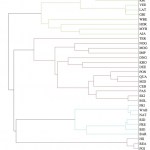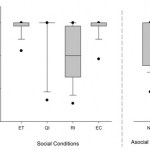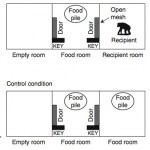Conflict & Cooperation
You know that old phrase, "monkey see, monkey do"? Well, there might be something to it, except that chimpanzees aren't monkeys. (Sadly, "ape see, ape do" just doesn't have the same ring to it.) A new paper published today in PLoS ONE has found evidence that chimpanzees have contagious yawning - that is, they can "catch" yawns from watching other chimpanzees yawning - but (and here's the interesting part) only when the chimp that they're watching is a friend.
At first, scientists thought that contagious yawning was the result of a releasing mechanism - in other words, seeing someone yawn…
I was reading Christie's excellent post (and you should too) on GoDaddy CEO Bob Parsons' elephant killing incident (is it too early to be calling this #ElephantGate?)
Although I don't know quite enough about what is going on in Zimbabwe, I tend to err on the side of not intentionally killing elephants because - as I argued for the case of chimpanzees - they are very likely self-aware.
I wrote:
There is another important cognitive capacity that unites animals with high encephalization quotients (the ratio of brain to body size - I recommend going back to read my earlier post for the context…
A new piece by me today at the Scientific American Guest Blog, on some exciting news from the Jane Goodall Institute and Duke University:
Fifty years ago, in the summer of 1960 - the same year that a US satellite snapped the first photo of the Earth from space, the same year that the CERN particle accelerator became operational, the same year that the Beatles got their name - a 26-year-old Jane Goodall got on a plane in London and went for the first time to Gombe Stream Game Reserve, in Tanzania. She carried with her only a notebook and some old binoculars. Almost every day since the day…
Welcome to the third installment of Animal Territoriality Week. See part 1 here, and part 2 here.
In 1994, a disease called sarcoptic mange swept through Bristol's fox population, severely crippling the population and killing most of the individuals. Professor Stephen Harris of the University of Bristol, who had been studying the movements and territories of those foxes, noticed that as the animals in one territory died, neighboring foxes were able to colonize the vacant areas in 3-4 days. He suspected that this was because the scent marks of the foxes remained active for 3-4 days, but didn'…
Welcome to Territoriality Week! Every day this week, I'll have a post about some aspect of animal or human territoriality. How do animals mark and control their territories? What determines the size or shape of an animal's territory? What can an animal's territory tell us about neuroanatomy? Today, I begin by asking two questions: first, what is the functional purpose of establishing territories? Second, to what extent can we apply findings from research on animal territorial behavior to understanding human territorial behavior?
It seems that everyone becomes an amateur animal behaviorist…
"At home, a young man should be dutiful towards his parents; going outside, he should be respectful towards his elders." -Confucius (Chinese philosopher, 551-479 BCE)
"Your real boss is the one who walks under your hat." -Napoleon Hill (American author, 1883-1970)
Those two quotations reflect a cultural difference in how people construct their own conceptions of who they are and how they interact with others. That the particular culture an individual is raised in helps to determine the way they understand the self is clear. Western cultures, such as in America or the UK, tend to focus on…
Eric M. Johnson and I spent about 45 minutes discussing "evolutionary psychology beyond sex" last night, which you can see today on Bloggingheads "Science Saturday."
Or just watch it here:
"Two chimps had been shut out of their shelter by mistake during a cold rain storm. They were standing dejeted, water streaming down their shivering bodies, when Professor Köhler chanced to pass." Upon opening the door for the two chimps, Dr. James Leuba recounts, "instead of scampering in without more ado, as many a child would have done, each of them delayed entering the warm shelter long enough to throw its arms around his benefactor in a frenzy of satisfaction."
"Chimpanzees," primatologist Frans de Waal points out, "do not normally hug their caretakers for no reason." It's a compelling…
Even still, we tend to think of the turkey as a fairly unintelligent bird, skilled at little more than waddling around, emitting the occasional "gobble," and frying up golden-brown-and-delicious. But...what if I told you that the domestic turkey (Meleagris gallopavo) could actually be quite clever, at least when it comes to social cognition? Apocryphal or not, Ben Franklin may have been on to something with the "Bird of Courage."
Head on over to Scientific American to catch my latest contribution to their Guest Blog: Turkey talk: The social cognition of your Thanksgiving dinner
Buchwalder, T…
Scientists thought they had a pretty good handle on the social interactions of bottlenose dophins (Tursiops). They've used the term fission-fusion dynamics to describe dolphin (and non-human primate) society and so far it has served researchers well. Fission-fusion societies among dolphins are characterized by two levels of social hierarchy: groups of two or three related males ("first-order alliances") which work together to guard one or more females from other males, and larger teams comprised of multiple related first-order alliances ("second-order alliances") which cooperate to "steal"…
Last night, I was a guest of the National Geographic Channel at the historic Saban Theater in Beverly Hills for the United States premiere of Great Migrations, which airs internationally on Sunday, November 7.
Great Migrations is a 7-part TV "event," paired with an issue of National Geographic magazine, a set of kids' books, iPhone apps, and so forth. The mini-series, narrated by Alec Baldwin, focuses on the movements of animals across the earth in an effort to find food, to mate, and to survive. The first hour, which was screened for us, featured the migration of the monarch butterfly from…
Ravi Iyer, a graduate student and colleague of mine at the University of Southern California in social psychology, blogs regularly about moral psychology at polipsych.com, and tweets from @ravi_polipsych. He collaborates with others on YourMorals.org, where interested individuals may participate in research in political and moral psychology. I asked him to contribute a guest post about his work.
As a moral psychology researcher, I was very excited when Jason wrote that his posts this week would cover moral psychology, and I have enjoyed his previous posts concerning the evolution of morality…
Cooperation and conflict are both a part of human society. While a good deal of the academic literature addresses the evolutionary origins of conflict, in recent years there has been an increased focus on the investigation of the evolutionary origins of cooperative behavior. One component of cooperative behavior that might be present in other animals is aversion to inequity. Some scientists have suggested that inequity aversion may itself be the main factor driving the enforcement of cooperation. Put simply, inequity aversion is the resistance among partners to unequal rewards following…
Bonobo Week continues! I'm donating whatever proceeds I receive from my blogging shenanigans for the entire month of June to help the bonobos at Lola Ya Bonobo.
Primate researchers used to think that only humans voluntarily share their own food with others. At the time, it was a reasonable conclusion to make, since lots of studies indicated that chimps don't. But that was before anyone checked to see if bonobos were willing to share their food with others.
So Brian Hare and Suzy Kwetuenda tested pairs of the bonobos from the Lola Ya Bonobo sanctuary in DRC. In all cases, the two…
